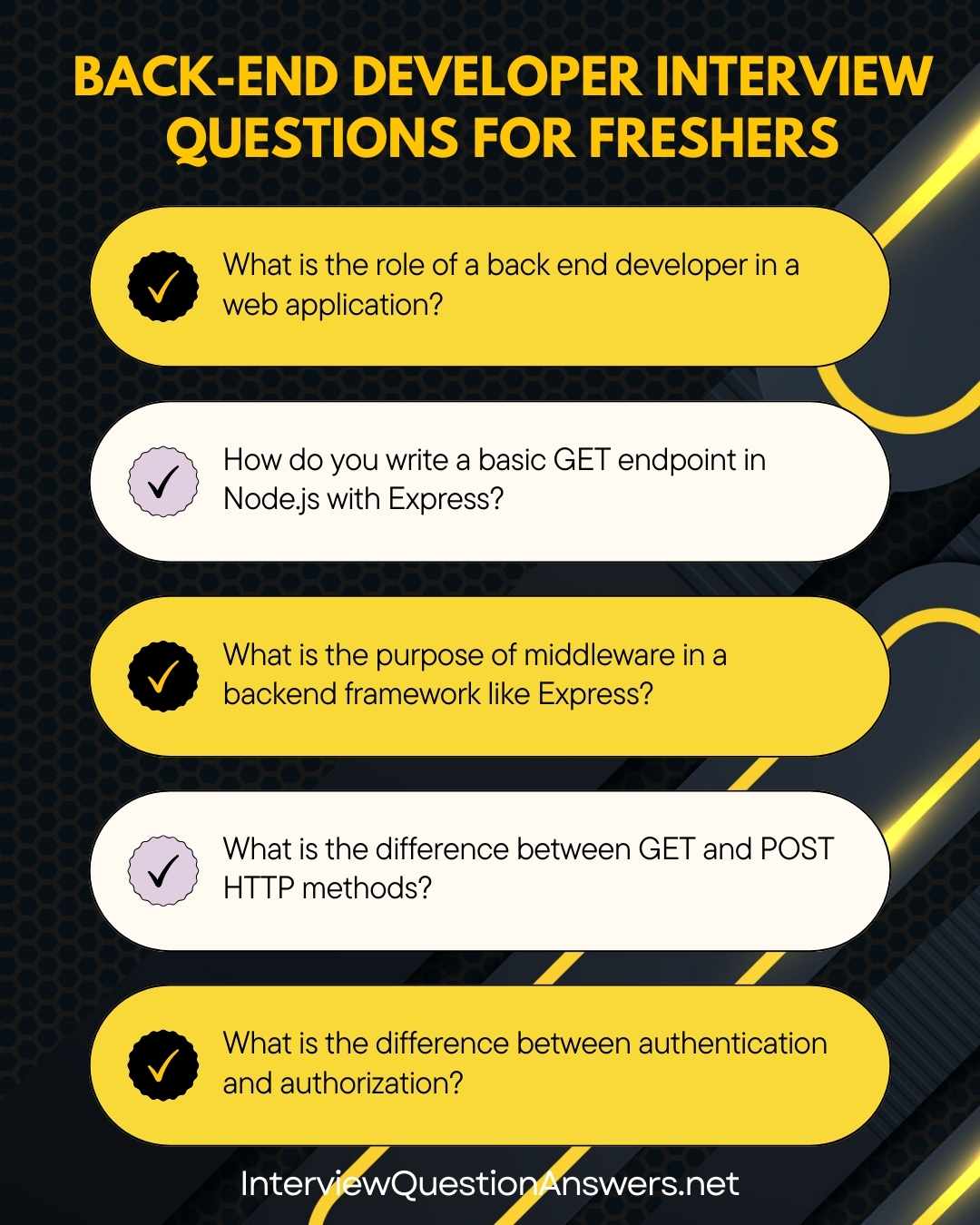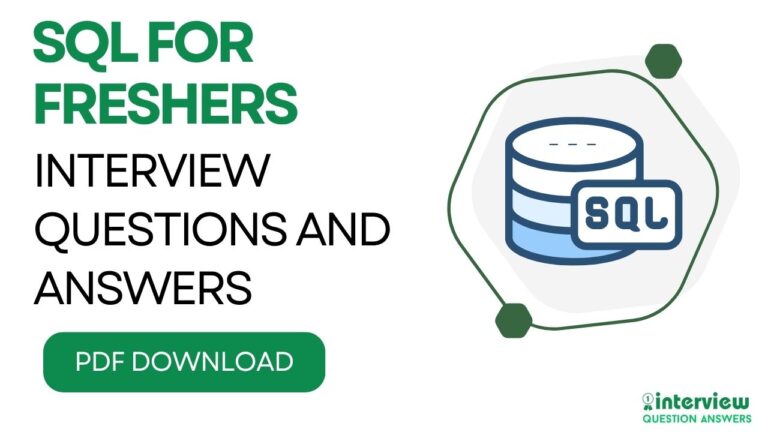Back End Developer Interview Questions for Freshers
Back End Developer Interview Questions for Freshers focus on server-side programming basics, database management skills, and API development knowledge that employers want from new graduates. Starting your back end development career requires understanding how servers work, how to store data properly, and how to connect different systems together.
Here we are covering Back End Developer Interview Questions for Freshers who want to get their first job in server-side development, including topics like programming languages, database queries, web services, and basic security practices. These Back End Developer Interview Questions for Freshers will help you explain your coding skills, show your understanding of server technologies, and prove you can build reliable applications that work behind the scenes.
You can also check our detailed guide: Top 100 Back End Developer Interview Questions and Answers PDF
Table of Contents
Entry Level Back End Developer Interview Questions
Que 1. What is the role of a back end developer in a web application?
Answer:
A back end developer builds and maintains the server-side logic, databases, and APIs that power a web application. They handle data storage, processing, and communication with the frontend, ensuring functionality, security, and performance.
Que 2. What is the difference between a database and a server?
Answer:
A database is a structured system for storing and managing data (e.g., MySQL, MongoDB), while a server is a computer or software that handles requests, runs application logic, and serves data to clients, often interacting with databases.
Que 3. What is a REST API, and why is it used?
Answer:
A REST API (Representational State Transfer) is a set of rules for building web services using HTTP methods (GET, POST, PUT, DELETE). It’s used for its simplicity, scalability, and statelessness, enabling communication between frontend and backend.
Que 4. How do you write a basic GET endpoint in Node.js with Express?
Answer:
Use Express to create a GET endpoint that returns data, typically in JSON format.
const express = require('express');
const app = express();
app.get('/api/users', (req, res) => {
res.json([{ id: 1, name: 'John' }]);
});
app.listen(3000);Que 5. What is the difference between SQL and NoSQL databases?
Answer:
SQL databases (e.g., PostgreSQL) are relational, use structured tables, and support SQL queries. NoSQL databases (e.g., MongoDB) are non-relational, handle unstructured data, and scale horizontally, ideal for flexible, large-scale data.
Que 6. How do you write a basic SQL SELECT query?
Answer:
A SELECT query retrieves data from a database, specifying columns and conditions.
SELECT name, age FROM users WHERE age > 18;Que 7. What is the purpose of middleware in a backend framework like Express?
Answer:
Middleware functions process requests in a pipeline, handling tasks like authentication, logging, or parsing. They run before the final route handler and can modify requests or responses.
app.use((req, res, next) => {
console.log('Request received');
next();
});Que 8. How do you connect a Node.js application to a database?
Answer:
Use a driver or ORM like pg for PostgreSQL or mongoose for MongoDB. Configure connection details and handle queries or operations.
const { Pool } = require('pg');
const pool = new Pool({
user: 'dbuser',
database: 'mydb',
password: 'secret',
host: 'localhost',
port: 5432
});
pool.query('SELECT * FROM users', (err, res) => {
console.log(res.rows);
});Que 9. What is the difference between GET and POST HTTP methods?
Answer:
GET retrieves data, is idempotent, and sends parameters in the URL. POST submits data in the request body, is non-idempotent, and is used for creating or updating resources.
Que 10. How do you handle errors in a backend application?
Answer:
Use try-catch for synchronous code, error-handling middleware for async operations, and return appropriate status codes. Log errors for debugging and provide user-friendly messages.
app.use((err, req, res, next) => {
console.error(err.stack);
res.status(500).send('Something went wrong');
});Que 11. What is CRUD, and how do you implement it in a REST API?
Answer:
CRUD stands for Create, Read, Update, Delete, corresponding to POST, GET, PUT, DELETE in REST. Implement with routes for each operation.
app.post('/users', (req, res) => { /* Create */ });
app.get('/users', (req, res) => { /* Read */ });
app.put('/users/:id', (req, res) => { /* Update */ });
app.delete('/users/:id', (req, res) => { /* Delete */ });Que 12. What is the purpose of environment variables in backend development?
Answer:
Environment variables store configuration settings (e.g., database credentials, API keys) securely, separate from code. Access them with process.env in Node.js.
const dbUrl = process.env.DATABASE_URL;Que 13. How do you prevent SQL injection in a backend application?
Answer:
Use parameterized queries or prepared statements to separate SQL from user input. ORMs like SQLAlchemy or Sequelize also help prevent injection.
# Using SQLAlchemy
from sqlalchemy.sql import text
query = text("SELECT * FROM users WHERE id = :id")
result = conn.execute(query, {"id": user_id})Que 14. What is the difference between authentication and authorization?
Answer:
Authentication verifies user identity (e.g., login with username/password). Authorization determines access rights (e.g., roles/permissions). Implement with JWT for auth and role-based checks for authorization.
Que 15. How do you implement basic authentication in a Node.js API?
Answer:
Use JWT or basic auth middleware to verify credentials. Return a token or check headers for authentication.
const basicAuth = require('express-basic-auth');
app.use(basicAuth({
users: { 'admin': 'password' }
}));Que 16. What is the purpose of a primary key in a database?
Answer:
A primary key uniquely identifies each record in a table, ensuring data integrity. It’s used for indexing and linking tables via foreign keys.
CREATE TABLE users (
id INT PRIMARY KEY,
name VARCHAR(255)
);Que 17. How do you handle file uploads in a backend application?
Answer:
Use middleware like multer in Express to process file uploads, configure storage, and validate file types.
const multer = require('multer');
const upload = multer({ dest: 'uploads/' });
app.post('/upload', upload.single('file'), (req, res) => {
res.send('File uploaded');
});Que 18. What is CORS, and how do you handle it in a backend application?
Answer:
CORS (Cross-Origin Resource Sharing) controls browser access to resources across domains. Enable it with specific origins or allow all in Express.
const cors = require('cors');
app.use(cors({ origin: 'http://example.com' }));Que 19. How do you write a basic POST endpoint in Python with Flask?
Answer:
Use Flask to handle POST requests, parse JSON data, and return responses.
from flask import Flask, request
app = Flask(__name__)
@app.route('/api/users', methods=['POST'])
def create_user():
data = request.json
return {"message": f"Created user {data['name']}"}Que 20. What is the difference between synchronous and asynchronous programming in backend development?
Answer:
Synchronous code blocks execution until complete (e.g., file reading). Asynchronous code uses callbacks, promises, or async/await to handle tasks like API calls without blocking.
const fs = require('fs').promises;
async function readFile() {
const data = await fs.readFile('file.txt', 'utf8');
console.log(data);
}
Also check: Backend Developer Interview Questions for Experienced
Most Common Back End Developer Interview Questions for Freshers
Que 21. What is the purpose of a foreign key in a relational database?
Answer:
A foreign key is a column in one table that references the primary key of another table, establishing a relationship between them. It ensures referential integrity, preventing invalid data entries.
CREATE TABLE orders (
id INT PRIMARY KEY,
user_id INT,
FOREIGN KEY (user_id) REFERENCES users(id)
);Que 22. How do you handle JSON data in a backend API?
Answer:
Parse incoming JSON with middleware (e.g., express.json() in Node.js) and return JSON responses. Validate data structure and handle errors gracefully.
const express = require('express');
const app = express();
app.use(express.json());
app.post('/api/data', (req, res) => {
const data = req.body;
res.json({ message: 'Received', data });
});Que 23. What is the difference between INNER JOIN and LEFT JOIN in SQL?
Answer:INNER JOIN returns rows where there’s a match in both tables. LEFT JOIN returns all rows from the left table, with matching rows from the right table (or NULL if no match).
SELECT users.name, orders.id
FROM users
INNER JOIN orders ON users.id = orders.user_id;Que 24. How do you secure an API endpoint in a backend application?
Answer:
Use authentication (e.g., JWT, OAuth), enforce HTTPS, and validate inputs. Implement rate limiting and use environment variables for sensitive data like API keys.
const jwt = require('jsonwebtoken');
function auth(req, res, next) {
const token = req.header('Authorization');
if (!token) return res.status(401).send('Unauthorized');
jwt.verify(token, process.env.JWT_SECRET, (err) => {
if (err) return res.status(403).send('Invalid token');
next();
});
}Que 25. What is the purpose of indexing in a database?
Answer:
Indexing speeds up query performance by creating a data structure (e.g., B-tree) for fast lookups. It’s useful for frequently queried columns but increases write time.
CREATE INDEX idx_name ON users(name);Que 26. How do you handle asynchronous operations in a Node.js backend?
Answer:
Use promises or async/await for non-blocking operations like database queries or API calls. Handle errors with try-catch blocks.
async function fetchData() {
try {
const response = await fetch('https://api.example.com/data');
return await response.json();
} catch (error) {
console.error('Error:', error);
}
}Que 27. What is the difference between a session and a token in authentication?
Answer:
A session stores user data on the server (e.g., session ID in a cookie), while a token (e.g., JWT) is stateless, containing user data signed and verified client-side. Tokens are scalable but require secure handling.
Que 28. How do you validate user input in a backend application?
Answer:
Use libraries like Joi (Node.js) or pydantic (Python) to validate input schemas. Check for required fields, data types, and constraints before processing.
const Joi = require('joi');
const schema = Joi.object({
username: Joi.string().min(3).required()
});
app.post('/api/user', (req, res) => {
const { error } = schema.validate(req.body);
if (error) return res.status(400).send(error.details[0].message);
});Que 29. What is an ORM, and how does it simplify database operations?
Answer:
An ORM (Object-Relational Mapping) like Sequelize or Django ORM maps database tables to objects, simplifying CRUD operations with code instead of raw SQL. It reduces boilerplate but may add overhead.
# Django ORM example
from django.db import models
class User(models.Model):
name = models.CharField(max_length=255)Que 30. How do you implement logging in a backend application?
Answer:
Use logging libraries like Winston (Node.js) or Python’s logging module to record events, errors, and debugging info. Configure levels (info, error) and output to files or services like ELK.
const winston = require('winston');
const logger = winston.createLogger({
transports: [new winston.transports.File({ filename: 'app.log' })]
});
logger.info('Server started');Que 31. What is the purpose of a .env file in backend development?
Answer:
A .env file stores environment-specific configuration (e.g., database URLs, API keys) securely, loaded with libraries like dotenv. It keeps sensitive data out of source code.
require('dotenv').config();
const dbUrl = process.env.DATABASE_URL;Que 32. How do you handle database connection pooling?
Answer:
Use connection pooling (e.g., pg-pool in Node.js) to reuse database connections, reducing overhead. Configure pool size based on traffic and database limits.
const { Pool } = require('pg');
const pool = new Pool({
connectionString: process.env.DATABASE_URL,
max: 20
});Que 33. What is the difference between a monolithic and microservices architecture?
Answer:
Monolithic architecture combines all components into a single application, simpler to develop but harder to scale. Microservices split functionality into independent services, scalable but complex to manage.
Que 34. How do you write a DELETE endpoint in Flask?
Answer:
Use Flask’s @app.route with methods=['DELETE'] to handle delete requests, typically targeting a resource by ID.
from flask import Flask
app = Flask(__name__)
@app.route('/api/users/<int:id>', methods=['DELETE'])
def delete_user(id):
# Delete logic
return {"message": f"User {id} deleted"}Que 35. What is the role of HTTP status codes in a backend API?
Answer:
HTTP status codes indicate the result of a request (e.g., 200 OK, 404 Not Found, 500 Internal Server Error). They help clients understand success, errors, or required actions.
Que 36. How do you test a backend API during development?
Answer:
Use tools like Postman or cURL to send requests and validate responses. Write automated tests with pytest (Python) or Mocha (Node.js), mocking dependencies for reliability.
# pytest example
import requests
def test_get_users():
response = requests.get('http://localhost:3000/api/users')
assert response.status_code == 200Que 37. What is the purpose of a transaction in a database?
Answer:
A transaction ensures a series of operations are executed as a single unit, maintaining data consistency with ACID properties. Roll back on failure.
BEGIN;
INSERT INTO users (name) VALUES ('John');
COMMIT;Que 38. How do you handle file storage in a backend application?
Answer:
Store files in cloud storage (e.g., AWS S3) or a local filesystem. Use libraries like multer (Node.js) or boto3 (Python) to manage uploads and secure access.
# boto3 S3 example
import boto3
s3 = boto3.client('s3')
s3.upload_file('file.txt', 'my-bucket', 'file.txt')Que 39. What is the difference between a cookie and a JWT?
Answer:
A cookie stores data (e.g., session ID) on the client, sent automatically with requests. A JWT is a self-contained token with encoded user data, verified server-side, ideal for stateless authentication.
Que 40. How do you optimize a backend API for performance?
Answer:
Cache responses with Redis, use indexing for database queries, and implement pagination for large datasets. Optimize endpoints with async processing and monitor with tools like Prometheus.
app.get('/api/users', async (req, res) => {
const cached = await redis.get('users');
if (cached) return res.json(JSON.parse(cached));
const users = await db.query('SELECT * FROM users LIMIT 10');
await redis.set('users', JSON.stringify(users));
res.json(users);
});Advanced Back End Developer Interview Questions for Freshers
Que 41. How do you implement a caching strategy in a backend API to improve performance?
Answer:
Use in-memory caching with Redis or Memcached to store frequently accessed data. Implement cache-aside or write-through strategies, set expiration times, and invalidate cache on data updates. Monitor cache hit rates to optimize.
const redis = require('redis');
const client = redis.createClient();
app.get('/api/data', async (req, res) => {
const cached = await client.get('data');
if (cached) return res.json(JSON.parse(cached));
const data = await db.query('SELECT * FROM data');
await client.setEx('data', 3600, JSON.stringify(data));
res.json(data);
});Que 42. What is the difference between horizontal and vertical scaling in backend systems?
Answer:
Horizontal scaling adds more servers to distribute load (e.g., adding nodes in a cluster). Vertical scaling increases a server’s resources (e.g., CPU, RAM). Horizontal is more flexible for distributed systems but requires load balancing.
Que 43. How do you handle database transactions across multiple tables?
Answer:
Use transactions to ensure atomicity across operations. In SQL, wrap operations in BEGIN/COMMIT, and rollback on errors. With ORMs like SQLAlchemy, use session management.
from sqlalchemy import create_engine
engine = create_engine('sqlite:///example.db')
with engine.begin() as conn:
conn.execute('INSERT INTO users (name) VALUES (?)', ('John',))
conn.execute('INSERT INTO orders (user_id) VALUES (?)', (1,))Que 44. What is a message queue, and how do you use it in a backend application?
Answer:
A message queue (e.g., RabbitMQ, AWS SQS) enables asynchronous communication between services. Producers send messages to queues, and consumers process them, improving scalability and fault tolerance.
import pika
connection = pika.BlockingConnection(pika.ConnectionParameters('localhost'))
channel = connection.channel()
channel.queue_declare(queue='tasks')
channel.basic_publish(exchange='', routing_key='tasks', body='Process data')
connection.close()Que 45. How do you prevent Cross-Site Request Forgery (CSRF) in a backend API?
Answer:
Use CSRF tokens in forms, validated on the server. In Express, use csurf middleware; in Django, include {% csrf_token %}. Ensure tokens are unique and tied to user sessions.
const csurf = require('csurf');
app.use(csurf());
app.post('/form', (req, res) => {
res.send('Form submitted');
});Que 46. What is the purpose of dependency injection in backend development?
Answer:
Dependency injection provides dependencies externally (e.g., via constructor), improving modularity and testability. In Spring (Java), use @Autowired or constructor injection.
public class Service {
private final Database db;
public Service(Database db) {
this.db = db;
}
}Que 47. How do you implement rate limiting in a backend application?
Answer:
Use middleware like express-rate-limit or flask-limiter with Redis to track requests per user/IP. Configure limits and handle exceeded requests with appropriate responses.
from flask_limiter import Limiter
app = Flask(__name__)
limiter = Limiter(app, default_limits=["100 per hour"])
@app.route('/api')
@limiter.limit("10 per minute")
def api():
return {"message": "Hello"}Que 48. What is the difference between a hash table and a binary search tree (BST)?
Answer:
A hash table uses a hash function for O(1) average-case lookups but requires collision handling. A BST organizes data hierarchically for O(log n) lookups, suitable for ordered data but slower for unbalanced trees.
Que 49. How do you handle file uploads securely in a backend application?
Answer:
Validate file types and sizes, use libraries like multer (Node.js) or boto3 (Python), and store files in secure cloud storage (e.g., AWS S3). Scan files for malware and restrict access.
const multer = require('multer');
const upload = multer({
dest: 'uploads/',
fileFilter: (req, file, cb) => {
if (!file.mimetype.startsWith('image/')) return cb(new Error('Invalid file type'));
cb(null, true);
}
});Que 50. What is the role of a load balancer in a backend system?
Answer:
A load balancer distributes incoming traffic across multiple servers to ensure scalability and availability. Use tools like AWS ELB or Nginx, configuring health checks and sticky sessions.
# Nginx load balancer config
upstream backend {
server backend1.example.com;
server backend2.example.com;
}
server {
listen 80;
location / {
proxy_pass http://backend;
}
}Que 51. How do you implement pagination in a REST API?
Answer:
Use query parameters like page and limit to return subsets of data. Include metadata (e.g., total pages) in responses and optimize database queries with OFFSET and LIMIT.
app.get('/api/users', async (req, res) => {
const page = parseInt(req.query.page) || 1;
const limit = parseInt(req.query.limit) || 10;
const offset = (page - 1) * limit;
const users = await db.query('SELECT * FROM users LIMIT $1 OFFSET $2', [limit, offset]);
res.json({ users, page, total: users.count });
});Que 52. What is the difference between synchronous and asynchronous I/O in backend development?
Answer:
Synchronous I/O blocks execution until complete (e.g., file reading). Asynchronous I/O uses callbacks, promises, or async/await for non-blocking operations, improving performance for I/O-bound tasks.
const fs = require('fs').promises;
async function readFile() {
const data = await fs.readFile('file.txt', 'utf8');
return data;
}Que 53. How do you handle database connection errors in a backend application?
Answer:
Implement retry logic with exponential backoff, use connection pooling (e.g., pg-pool), and log errors. Provide fallback mechanisms and graceful degradation for user experience.
const { Pool } = require('pg');
const pool = new Pool({ connectionString: process.env.DATABASE_URL });
pool.on('error', (err) => {
console.error('Database error:', err);
});Que 54. What is a design pattern, and can you explain the Factory pattern?
Answer:
A design pattern is a reusable solution to common problems. The Factory pattern creates objects without specifying the exact class, using a factory method for instantiation.
class Animal:
def speak(self): pass
class Dog(Animal):
def speak(self): return "Woof"
class Cat(Animal):
def speak(self): return "Meow"
def animal_factory(type):
return {'dog': Dog, 'cat': Cat}[type]()Que 55. How do you implement logging for debugging in a backend application?
Answer:
Use structured logging with Winston (Node.js) or Python’s logging module. Configure levels (info, error), log to files or services like ELK, and include request IDs for traceability.
import logging
logging.basicConfig(filename='app.log', level=logging.INFO)
logging.info('Server started', extra={'request_id': '123'})Que 56. What is the purpose of a reverse proxy in a backend system?
Answer:
A reverse proxy (e.g., Nginx, HAProxy) forwards client requests to backend servers, providing load balancing, caching, and security. It hides server details and improves performance.
server {
listen 80;
location / {
proxy_pass http://backend;
}
}Que 57. How do you implement a basic GraphQL API in a backend application?
Answer:
Use libraries like Apollo Server (Node.js) or Graphene (Python) to define schemas and resolvers. Expose a single endpoint for queries and mutations.
const { ApolloServer, gql } = require('apollo-server');
const typeDefs = gql`
type Query {
hello: String
}
`;
const resolvers = { Query: { hello: () => 'Hello, World!' } };
const server = new ApolloServer({ typeDefs, resolvers });
server.listen();Que 58. How do you handle versioning in a REST API?
Answer:
Version APIs via URL paths (e.g., /v1/users), headers, or query parameters. Maintain backward compatibility, document changes, and deprecate old versions gradually.
app.get('/api/v1/users', (req, res) => {
res.json({ version: 'v1', users: [] });
});Que 59. What is the difference between a stack and a queue in backend processing?
Answer:
A stack follows Last-In-First-Out (LIFO), used for tasks like function calls. A queue follows First-In-First-Out (FIFO), used for task scheduling or message queues.
class Queue:
def __init__(self):
self.items = []
def enqueue(self, item):
self.items.append(item)
def dequeue(self):
return self.items.pop(0) if self.items else NoneQue 60. How do you test a backend API for reliability?
Answer:
Write unit tests with pytest or Mocha, mock dependencies with unittest.mock or sinon, and use tools like Postman for integration tests. Automate with CI/CD and monitor with tools like Prometheus.
import pytest
import requests
def test_api():
response = requests.get('http://localhost:3000/api')
assert response.status_code == 200Conclusion
The back end development field is growing quickly with cloud services, API frameworks, and database technologies becoming necessary skills for entry-level positions. These Back End Developer Interview Questions for Freshers give you the strong foundation needed for your job search, covering everything from simple database operations to complex server configurations.
You can also check:













